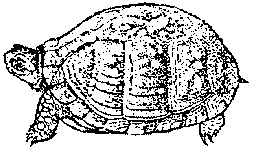 |
Science Frontiers ONLINE No. 65: Sep-Oct 1989 |
|
|
The Wood Turtle Stomp
J.H. Kaufmann is a zoologist with strong proclivities for wood-turtle watching. Not a very strenuous vocation you say! Be that as it may, wood turtles make up for their lack of speed with some interesting talents. Besides being able to home accurately over unfamiliar terrain, they also know how to "grunt" - not vocal grunting, but a much more curious activity. Kaufmann relates one of his observations:
"I came upon an adult male. When I first saw him he was sitting quietly beside a creek, but he soon wandered into a damp thicket of alder, spicebush, and false hellebore. Before disappearing from sight, however, he began to rock back and forth. I followed, trying to stay just close enough to see what he was up to without disturbing him. Fortunately, he did not scare easily, which allowed me to approach within a few yards as he meandered, walking and rocking. First, I noticed that the rocking was caused by short bouts of stomping with the front feet, alternating between left and right. Then he suddenly jabbed his head at the ground and ate something. This behavior continued for a half hour, and several times I caught a glimpse of the prey - earthworms snatched from the surface. I suddenly realized the turtle was 'grunting' for worms!"
 Turtle preparing to stomp; i.e. 'grunt'. |
Back to wood turtles, how do they acquire this skill? Even naive, artificially raised wood turtles know the technique! And what great fear drives the earthworms out of the ground? Some say that the vibrations make the worms think moles are chasing them.
(Kaufmann, John H.; "The Wood Turtle Stomp," Natural History, 98:8, August 1989.)